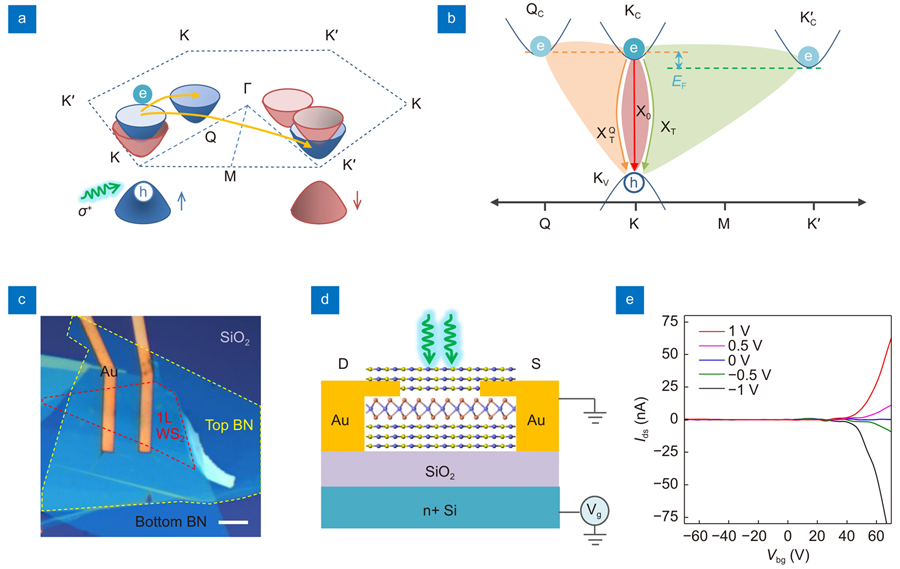Jiajie Pei, Xue Liu, Andrés Granados del Águila, Di Bao, Sheng Liu, Mohamed-Raouf Amara, Weijie Zhao, Feng Zhang, Congya You, Yongzhe Zhang, Kenji Watanabe, Takashi Taniguchi, Han Zhang, Qihua Xiong. Switching of K-Q intervalley trions fine structure and their dynamics in n-doped monolayer WS2[J]. Opto-Electronic Advances, 2023, 6(4): 220034
Search by keywords or author
- Opto-Electronic Advances
- Vol. 6, Issue 4, 220034 (2023)

Fig. 1. Schematic diagram and device characterization. (a ) Schematic drawing of the spin configurations for monolayer WS2 in the conduction band and valence band at K and K’ point of the first Brillouin zone. The bands with two different spin configurations are schematically drawn using two different colors (blue and red), annotated with arrows representing different spins. The symbols “e” and “h” represent electrons and holes, respectively. Scattering pathways of electrons are denoted by the orange arrows. The green wavy arrow represents the excitation photons. (b ) The possible valley exciton and trions emissions from KV valley in the momentum space. Upon linear optical excitation, the landscape of excitons and trions with opposite spin configurations degenerates. Here, we display the valley excitons and trions for only one spin configuration. Fermi level changes are represented by orange and green dashed lines. The Coulomb interactions of exciton and trions are denoted by the filled areas with red, orange, and green colors. (c ) Optical micrograph of the h-BN/1L-WS2/h-BN sandwiched sample. The scale bar is 5 μm. (d ) Schematic plot of the heterostructure device. (e ) The drain-source current as a function of back-gate voltage for various source-drain biases. With this transition curve, it is found the WS2 monolayer is an n-type semiconductor. Note that the gate-dependent PL measurement in the main text is measured at zero source-drain bias.

Fig. 2. Electrical tuning of the PL spectra of excitonic species . (a ) A typical PL spectrum of the monolayer WS2 at T=10 K excited by 2.33 eV laser. The label X0 and XT represent bright exciton and trion, respectively. The labels
b ) Color plot of the measured PL spectra for monolayer WS2 as a function of back-gate voltage at 25 μW excitation power. The black dashed lines are a guide to the eye showing the positions of the emission peaks. The red dashed arrow illustrates the transition trend for XX– peak intensity under doping, which should be opposite to the
c ) Integrated PL intensities of the X0 (black circle), XT (blue circle), and
Fig. 3. Influence of electrical doping on the carrier dynamics of excitonic species. (a , b ) Normalized PL spectra at per μW excitation power for monolayer WS2 as a function of excitation power at –60 V and 60 V back gate voltages. The dashed lines are guided to the eye showing the peak positions of X0 andc ) Log-log plot of the integrated PL intensity ford ) Measured time-resolved PL traces (dots) for the XT ande ) Measured time-resolved PL traces (dots) for thef ) The statistical values of the fast decay lifetime τ1 and slow decay lifetime τ2 for the fitting results of XT and
Fig. 4. Temperature-dependent PL spectra of the monolayer WS2. (a ) PL spectra at different temperatures from 295 K to 10 K. The spectra are vertically shifted for clarity. The dashed lines are a guide to the eye showing the peak positions of X0, XT andb ) Peak energy of X0, XT andc ) Integrated PL intensity of X0, XT, andd ) Schematic drawing of the thermalization induced shrinking and expansion of lattice and related bandgap renormalization. (e ) The Q-K valley energy difference at each temperature that extracted from the fit of the experimental results in c based on the equations in Supplementary information Section 1. The temperature-dependent ΔEQK is about twice the energy offset value of the X0 peak, which implies that the offset between the K-Q valleys is in the opposite direction.

Set citation alerts for the article
Please enter your email address



